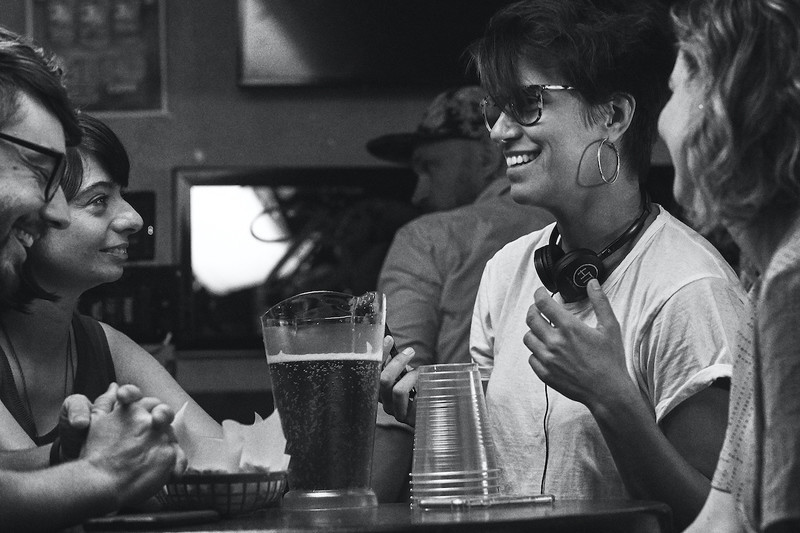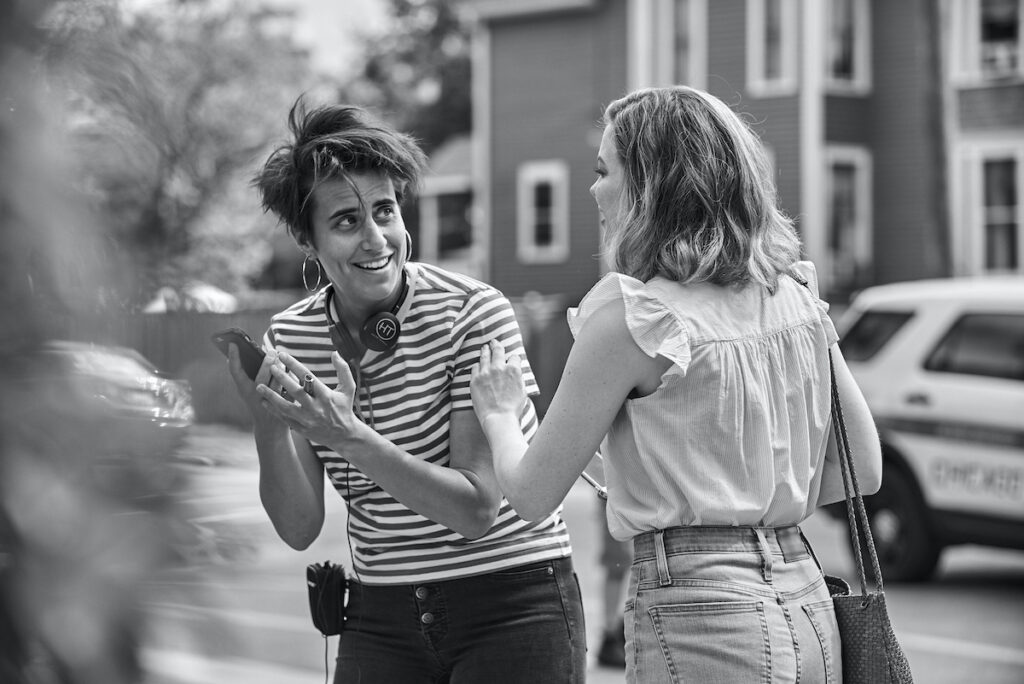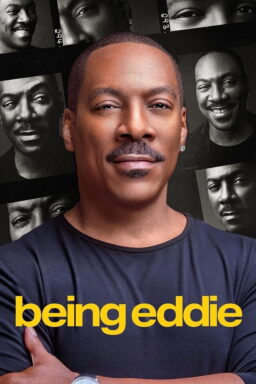There are few places better suited for unintentional comedy than Zoom. At the end of my chat last week with writer/director Kris Rey and actor Gillian Jacobs about their wonderful new movie, “I Used to Go Here,” I thanked them for their time and patiently waited for the publicist to end our call. Several seconds went by until I realized that I was the one who had to press the “Leave” button, a delayed epiphany that elicited peals of guffaws from both Rey and Jacobs. It’s the sort of moment that would’ve felt right at home in their film, where many of the biggest laughs are earned by subtle inflections or awkward pauses.
Jacobs, who has always been a joy to watch on such beloved shows as “Community” and “Love,” plays Kate, a writer in her mid-30s who returns to her former college, Southern Illinois University (Rey’s real-life alma mater), to discuss her newly published book. While there, she reconnects with David (Jemaine Clement), the professor she once idolized, while forging unexpected friendships with students like Hugo (Josh Wiggins). The talent-packed ensemble also features Hannah Marks, Jorma Taccone, Kate Micucci, Rammel Chan and an uproarious newcomer, Brandon Daley, whose character continuously threatens to walk away with the picture.
When I first interviewed Rey (formerly Swanberg) eight years ago, she noted that one of the defining themes of her work is the “quest for independence,” which was reflected in her first directorial feature, 2009’s “It Was Great, But I Was Ready to Come Home.” Whereas that film finds its heroine traveling to an exotic locale, “I Used to Go Here” is about a woman revisiting her past, and Rey’s tirelessly independent spirit has never felt as liberated as it does here, especially during the picture’s perfectly pitched final moments. In the following conversation, Rey and Jacobs spoke with RogerEbert.com about how their set felt like a family, the value in learning from younger people and their cherished memories of the late great filmmaker Lynn Shelton.
Though I’ve admired all of Kris’ work over the years, none of her films have made me laugh out loud as much as this one. What appealed to you both about one another’s approach to comedy?
Kris Rey (KR): I think Gillian and I have a really similar sensibility to what we think is funny. I haven’t actually articulated that before, but I think that’s a big part of what made the experience of making this film so fluid for us. I would be like, ‘Wouldn’t it be funny if you did this?’ And she would be like, ‘Yeah, that is hilarious.’ [laughs] We were pretty much always on the same page about the kind of humor that we’re into. “I Used to Go Here” is certainly my funniest film, since my early films are not very funny at all. I’m glad it made you laugh out loud. That’s nice to hear.
Gillian Jacobs (GJ): The script felt grounded in real life but also slightly absurd in the way that life can get slightly absurd with some of the misadventures that the characters embark on together. Kris is so skilled at portraying the little humiliations of life and the painful, awkward moments that are horrible for you but also funny for an audience. I like small details, such as how Kate is fixated on how bad the cover for her book is, and can’t let it go. That felt very real. I’ve talked to a lot of friends who are authors who felt similarly and were so upset about their book cover that they couldn’t stop bringing it up to people who don’t really care. [laughs] My character felt like a person I knew who just happened to be in slightly extreme circumstances that are really funny.
One of the funniest things I’ve ever seen was Gillian’s impression of Gena Rowlands as an umpire in Mike Birbiglia’s 2016 gem, “Don’t Think Twice,” and many of Kris’ early films have earned comparisons to Rowlands’ collaborations with John Cassavetes, which share a documentary-level authenticity.
GJ: This is so funny that you say this because I did an interview earlier today where I was asked what type of movies I wanted to make, and I said, “Anything with Gena Rowlands and John Cassavetes.” I honestly don’t remember whether it was my idea to do that impression, but I do remember that Mike originally had at least one impression that I knew I couldn’t do in “Don’t Think Twice.” Gena Rowlands is absolutely a huge inspiration to me.
KR: Cassavetes was also a huge influence on me, especially in the way that I started making films. Even though this film had a much bigger cast and crew than some of my earlier work—and certainly Cassavetes’ work—it did feel small. I think that the atmosphere and the vibe of having a small family is what people felt on the set. I actually love production precisely because of that closeness. I made an effort to take that with me to this movie, and I think I succeeded.
GJ: It’s true. People always say that a film set is like a family, but I feel like this set was the best embodiment of that I have seen. It’s funny because I don’t live in Chicago, so in some ways, I was an outsider stepping into this family. A lot of the cast, and the crew especially, have worked together many times, so they have a lot of history, and I found that really inspiring to see. You hear about this sort of family dynamic on sets all the time, but it was on this set where I really saw it in action for the first time.

What attracts you to finding the through-lines between different generations? This theme is explored so insightfully in “I Used to Go Here” and Kris’ previous directional effort, “Unexpected.”
KR: It’s something I think about constantly as I get older. People have talked forever in stories and just in real life about this idea of not feeling as old as you often are. I’m always surprised when I connect with someone and I find out that they are 15 years younger than me. I’m like, ‘Oh damn, you’re 30 years old? But we’re like the same, right?’ [laughs] I don’t know if this is something everyone experiences, but I think that, as a filmmaker and probably as an actor, you’re paired up with people who are from different generations.
I suppose if your life consists of having a family, going to work and coming back home, you might not interact with people who are different ages than you oftentimes, but I find that I really do. I’m learning so much from people who are younger than me and I appreciate them so much. With my personality, I don’t see myself becoming a curmudgeon who thinks that young people don’t know what’s going on. They know exactly what’s going on. They are the ones who are creating and making art and coming up with new ideas and are energetic. I am drawn to that energy, and I think I will always be interested in stories about that.
GJ: We talked about that a lot when we first began discussing this project. I think we were both having a similar experience in that I grew up being the only kid in plays with a lot of adults, and I loved being around adults. For a long time, I was the youngest person, and when I realized that I wasn’t the youngest anymore, I made a conscious decision to handle it with grace while remaining open and excited.
I realized that I could learn so much from younger people. I feel that I have really great rewarding friendships with people who are younger than me, and through my conversations with Kris, those experiences are really in evidence in the film. Then when I actually made the film, I just loved the cast. I forgot how young many of the other actors were until they started talking about which TV shows they watched when they were kids. I had no idea what they were talking about, and then I would get very quiet. [laughs]
Two young members of the cast whom I must single out are Josh Wiggins, an actor I previously admired in Keith Behrman’s “Giant Little Ones,” and Brandon Daley, whose character Tall Brandon seems poised to have his own spin-off franchise.
KR: A lot of people have mentioned that! I sent Brandon a review where someone said that his character warrants his own spin-off, and he wrote me back and said, “Are you serious? Do you wanna write one? Let’s do it!” [laughs] Both of the actors you mentioned are great and they are also really different. I had first seen Josh in Kat Candler’s film, “Hellion,” where he was a kid. He was so natural in that film, and he had never acted before. I don’t know if he’s ever had any formal training since making that film, and he’s such an easy-going guy. Anytime I’d give him a note, he’d be like, ‘Cool, got it.’ He’s so cute and has this young Leo vibe, while also being a really sweet, thoughtful guy in real life. He’s just a pleasure to be around.
I actually wrote the character of Tall Brandon because of Brandon Daley, who is a Chicago guy. He went to Northwestern with the filmmaker Harrison Atkins, who is a friend I’ve had at our house parties. Brandon would often be Harrison’s plus one at these parties, and people used to call him Tall Brandon just to give him a hard time. I never had a conversation with the guy, but he’s 6’7” and he looks like he’s twelve years old. He was such a funny character to me that when I began writing all of the college-age characters, I named one of them Tall Brandon.
When real-life Brandon found out about this, he cornered me at a party and was like, ‘I heard you wrote a character that is based on me.’ I confessed that I had, and he asked, “Can I play him?” I didn’t know if it would work because he’s not really an actor, and I hadn’t even begun the casting process. Yet he insisted that I let him audition, so I made him put himself on tape to play the character based on himself, and the tape was so funny. [laughs] He ended up being one of the best parts of the whole film. I think he totally steals it.
Lynn Shelton once told me how deeply she was impacted by her collaborations with Kris. Her work had an honesty and a humanism that this film has as well.
KR: She was a big supporter of mine. We were really tight friends and we talked almost every day. She actually did get to see a rough cut of this film. There was a period where I was very stressed out about different aspects of the movie. We had done some reshoots and I kept weighing the options I had to figure out which direction the film should ultimately take. So Lynn and me and Kate Micucci all watched it at Kate’s apartment in LA, and Lynn gave me some great advice and feedback. She was definitely a fan of it, and I am so happy that she got to see it.

GJ: I learned so much from Lynn. Kris and I have had conversations about how special and important she was. I was not nearly as close of friends with her as Kris was, but she had a profound effect on me, and she taught me a lot when we did get to work together. In the first episode of “Love” that she directed, there was a sex scene. Lynn called me weeks in advance and said, “I want to talk through how we are going to portray female pleasure in this scene.” And I was like, ‘What?’ That is not a conversation that you typically have at all. I remember when we went to shoot the scene, and the room was so dimly lit that it looked like there wasn’t a single light in the room. We did about two takes and she said, “We got it.” Paul Rust and I looked at each other and were like, ‘Huh? We’re done?’
Those types of scenes can be very fraught experiences, and I never had a director talk to me in the way that she did. She was so thoughtful and deliberate and truly wanted to engage in these conversations. I also remember having rehearsal with her and Daniel Stern, who played my father. I was just very lucky to get to work with her on some very big episodes for my character on that show and I really felt like she brought so much to each of them. I am eternally grateful that I got to work with Lynn.
Kate’s line, “It could be better,” resonates so deeply with the current movement to right past wrongs in the era of COVID-19.
KR: I agree a hundred percent, especially right now with everything that is going on with the anti-racism movement. Of course, I couldn’t have predicted it and I wasn’t trying to make a statement on it, but this idea of owning your faults and your failures and accepting them is so hard to do. Making an effort to improve those faults is something that we are all learning to do right now, and I think it applies to so many things. In terms of my own journey and my own life, it is something that I am always trying to do. Over the last couple of years, I’ve had huge transitions in my life and trying to accept those and learn from them and move forward has been something that has really made me feel whole.
GJ: That line definitely speaks to me in a different way now. Back when we were shooting it, I connected with how Kate was being honest with herself, even if it’s just in a professional sense of, ‘Yeah, I wasn’t really that great in that thing. I could’ve tried harder, I could’ve dug deeper.’ But I don’t have a better answer than the one Kris just gave.
I love how Kris cast herself as the new flame of Kate’s ex, and according to the character’s Instagram page, her name is Rey.
KR: I think that account is still on Instagram. I don’t imagine that anyone took it down, so I’m sure it’s still floating around, which is so funny. [laughs] That decision was really, truly just a symptom of making an independent film. You can’t afford to pay somebody for that sort of role, so who are you going to get? I ended up casting Declan, the husband of our first AD, Morgan Jon Fox, as Kate’s ex-boyfriend. He’s wildly attractive and a good friend of mine, so he agreed to do it for free. Since we’re so tight, we didn’t even need to get a crew. We just shot everything on an iPhone, and that is why my cameo wound up in there. I had not thought through how present I would be in the shot that zooms in on her Instagram page. [laughs] It gets a laugh from people who know me every time.
Your film had its Chicago premiere last night at a drive-in. To what extent do these venues keep the communal moviegoing experience alive during a pandemic?
KR: The drive-in is cool! It has a huge air of nostalgia around it, so it doesn’t feel icky in the sense of this being our new future in a scary way. It simply feels like we’re going back to Americana, so it’s got a nice vibe to it while also providing a really safe way that we can collectively have an experience. I wish Gillian could’ve been there because it was so cool. Both screenings were sold out, and I could hear people laughing from inside their cars several rows away from me.
It wasn’t the same as a festival premiere, but it did have a similar feeling to what you get when you are watching your work in a crowded theater and people are laughing. There is nothing like it, and honestly, that’s what it is all for, at the end of the day. It takes so long and such a huge effort to make a film. You really want people to see it and you want to get that feedback. It’s so nice how drive-ins are serving that purpose. I think they are rad, and I hope we keep them around.












